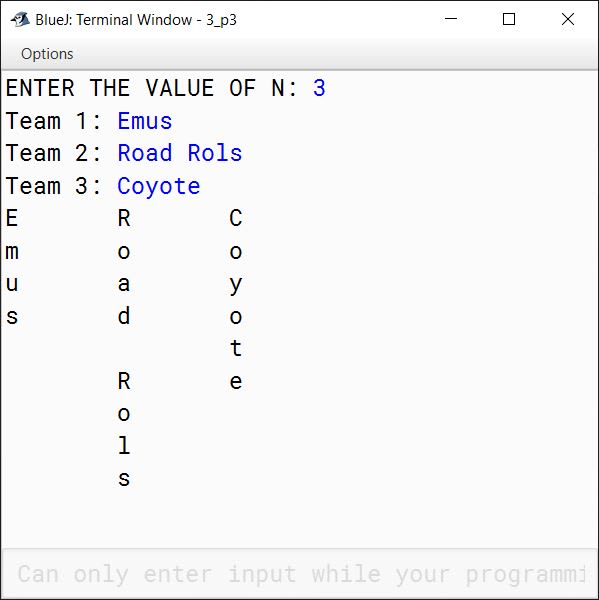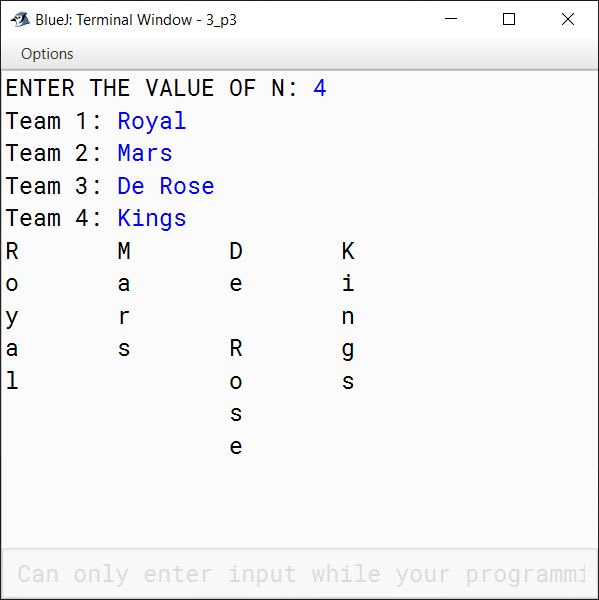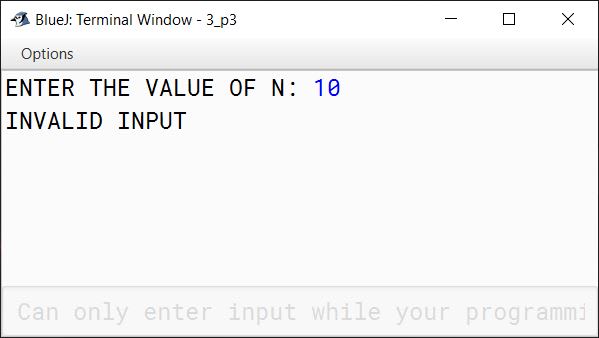Practical Questions
Question 1
A Goldbach number is a positive even integer that can be expressed as the sum of two odd primes.
Note: All even integer numbers greater than 4 are Goldbach numbers.
Example:
6 = 3 + 3
10 = 3 + 7
10 = 5 + 5
Hence, 6 has one odd prime pair 3 and 3. Similarly, 10 has two odd prime pairs, i.e. 3 and 7, 5 and 5.
Write a program to accept an even integer 'N' where N > 9 and N < 50. Find all the odd prime pairs whose sum is equal to the number 'N'.
Test your program with the following data and some random data:
Example 1
INPUT:
N = 14
OUTPUT:
PRIME PAIRS ARE:
3, 11
7, 7
Example 2
INPUT:
N = 30
OUTPUT:
PRIME PAIRS ARE:
7, 23
11, 19
13, 17
Example 3
INPUT:
N = 17
OUTPUT:
INVALID INPUT. NUMBER IS ODD.
Example 4
INPUT:
N = 126
OUTPUT:
INVALID INPUT. NUMBER OUT OF RANGE.
Solution
import java.util.Scanner;
public class GoldbachNumber
{
public static boolean isPrime(int num) {
int c = 0;
for (int i = 1; i <= num; i++) {
if (num % i == 0) {
c++;
}
}
return c == 2;
}
public static void main(String args[]) {
Scanner in = new Scanner(System.in);
System.out.print("ENTER THE VALUE OF N: ");
int n = in.nextInt();
if (n <= 9 || n >= 50) {
System.out.println("INVALID INPUT. NUMBER OUT OF RANGE.");
return;
}
if (n % 2 != 0) {
System.out.println("INVALID INPUT. NUMBER IS ODD.");
return;
}
System.out.println("PRIME PAIRS ARE:");
int a = 3;
int b = 0;
while (a <= n / 2) {
b = n - a;
if (isPrime(a) && isPrime(b)) {
System.out.println(a + ", " + b);
}
a += 2;
}
}
}Output
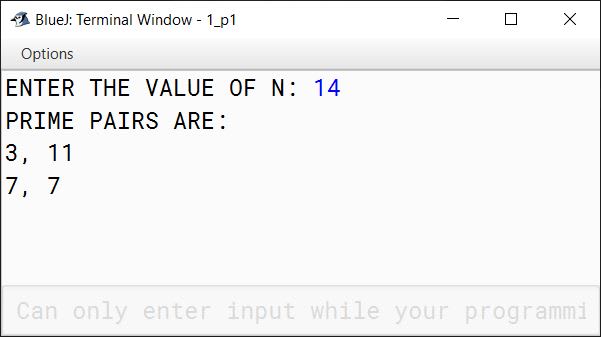


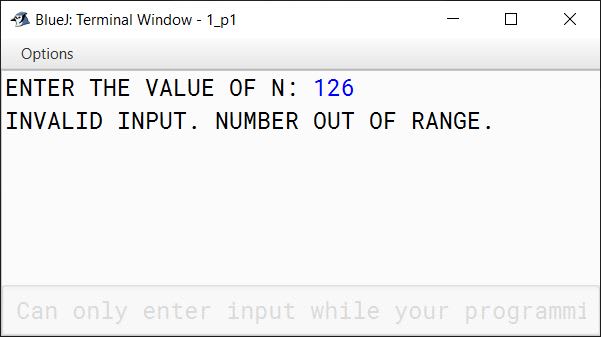
Question 2
Write a program to declare a matrix a[][] of order (m × n) where 'm' is the number of rows and 'n' is the number of columns such that the values of both 'm' and 'n' must be greater than 2 and less than 10. Allow the user to input integers into this matrix. Perform the following tasks on the matrix:
- Display the original matrix.
- Sort each row of the matrix in ascending order using any standard sorting technique.
- Display the changed matrix after sorting each row.
Test your program for the following data and some random data:
Example 1
INPUT:
M = 4
N = 3
ENTER ELEMENTS OF MATRIX:
OUTPUT:
ORIGINAL MATRIX
MATRIX AFTER SORTING ROWS
Example 2
INPUT:
M = 3
N = 3
ENTER ELEMENTS OF MATRIX
OUTPUT:
ORIGINAL MATRIX
MATRIX AFTER SORTING ROWS
Example 3
INPUT:
M = 11
N = 5
OUTPUT:
MATRIX SIZE OUT OF RANGE.
Solution
import java.util.Scanner;
public class ArraySort
{
public static void main(String args[]) {
Scanner in = new Scanner(System.in);
System.out.print("ENTER THE VALUE OF M: ");
int m = in.nextInt();
System.out.print("ENTER THE VALUE OF N: ");
int n = in.nextInt();
if (m <= 2
|| m >= 10
|| n <= 2
|| n >= 10) {
System.out.println("MATRIX SIZE OUT OF RANGE.");
return;
}
int a[][] = new int[m][n];
System.out.println("ENTER ELEMENTS OF MATRIX:");
for (int i = 0; i < m; i++) {
System.out.println("ENTER ELEMENTS OF ROW " + (i+1) + ":");
for (int j = 0; j < n; j++) {
a[i][j] = in.nextInt();
}
}
System.out.println("ORIGINAL MATRIX");
for (int i = 0; i < m; i++) {
for (int j = 0; j < n; j++) {
System.out.print(a[i][j] + " ");
}
System.out.println();
}
for (int i = 0; i < m; i++) {
for (int j = 0; j < n - 1; j++) {
for (int k = 0; k < n - j - 1; k++) {
if (a[i][k] > a[i][k + 1]) {
int t = a[i][k];
a[i][k] = a[i][k+1];
a[i][k+1] = t;
}
}
}
}
System.out.println("MATRIX AFTER SORTING ROWS");
for (int i = 0; i < m; i++) {
for (int j = 0; j < n; j++) {
System.out.print(a[i][j] + " ");
}
System.out.println();
}
}
}Output
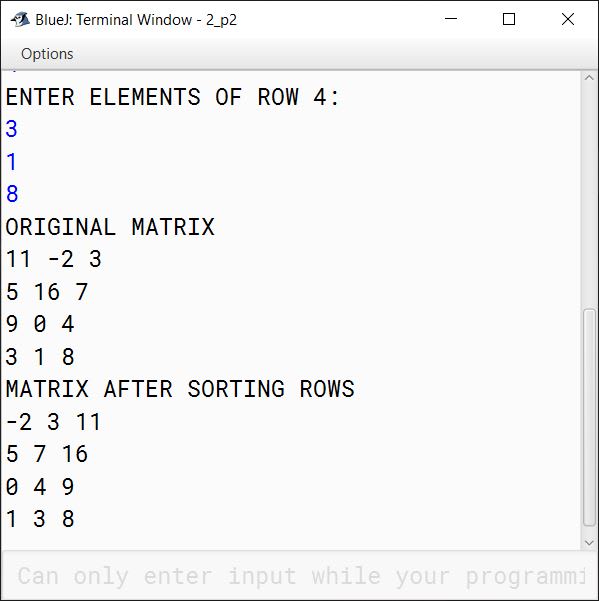
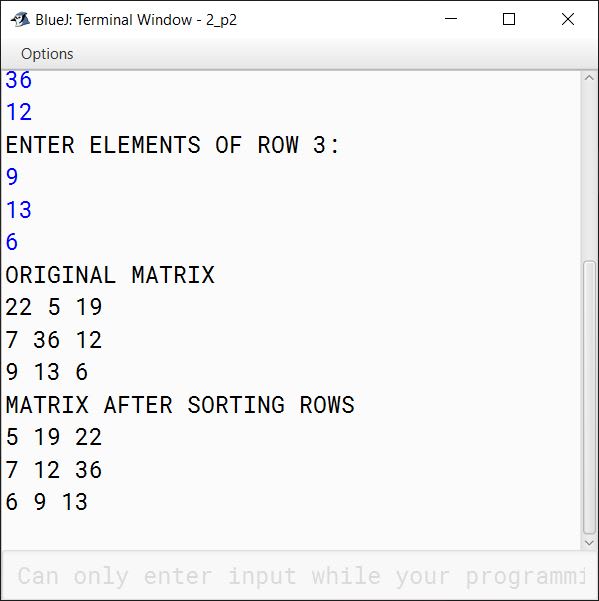

Question 3
The names of the teams participating in a competition should be displayed on a banner vertically, to accommodate as many teams as possible in a single banner. Design a program to accept the names of N teams, where 2 < N < 9 and display them in vertical order, side by side with a horizontal tab (i.e. eight spaces).
Test your program for the following data and some random data:
Example 1
INPUT:
N = 3
Team 1: Emus
Team 2: Road Rols
Team 3: Coyote
OUTPUT:
E R C
m o o
u a y
s d o
t
R e
o
l
s
Example 2
INPUT:
N = 4
Team 1: Royal
Team 2: Mars
Team 3: De Rose
Team 4: Kings
OUTPUT:
R M D K
o a e i
y r n
a s R g
l o s
s
e
Example 3
INPUT:
N = 10
OUTPUT:
INVALID INPUT
Solution
import java.util.Scanner;
public class Banner
{
public static void main(String args[]) {
Scanner in = new Scanner(System.in);
System.out.print("ENTER THE VALUE OF N: ");
int n = in.nextInt();
in.nextLine();
if (n <= 2 || n >= 9) {
System.out.println("INVALID INPUT");
return;
}
String teams[] = new String[n];
int highLen = 0;
for (int i = 0; i < n; i++) {
System.out.print("Team " + (i+1) + ": ");
teams[i] = in.nextLine();
if (teams[i].length() > highLen) {
highLen = teams[i].length();
}
}
for (int i = 0; i < highLen; i++) {
for (int j = 0; j < n; j++) {
int len = teams[j].length();
if (i >= len) {
System.out.print(" \t");
}
else {
System.out.print(teams[j].charAt(i) + "\t");
}
}
System.out.println();
}
}
}Output
